Briefly: In our opinion, full (150% of the regular full position) speculative short positions in gold, silver and mining stocks are justified from the risk/reward perspective at the moment of publishing this alert.
Quite a lot happened in the precious metals market last week, but the biggest change was seen in the silver market. The white metal previously received a lot of attention from precious metals bulls after it had broken above the declining resistance line based on both intraday and weekly closing prices. Silver already invalidated the breakout above the line based on intraday highs several days ago and based on Friday’s closing prices, silver closed the week below the long-term support/resistance line, thus invalidating the breakdown also in terms of weekly closes. Are the implications as bearish as they appear at first sight?
In short, they are. While the breakouts and breakdowns usually require a confirmation, be that in the form of three consecutive closes above/below a certain level, huge volume, or a huge price different between the price and the level that was broken, it is not the case with invalidations. Once the breakdown/breakout is invalidated, the implications quickly reverse. In the case of silver, the previous breakouts and their supposedly (we never believed it) bullish implications were reversed and are now clearly bearish. The implications are bearish not only for the short, but also for the medium term. Let’s take a closer look (charts courtesy of http://stockcharts.com).
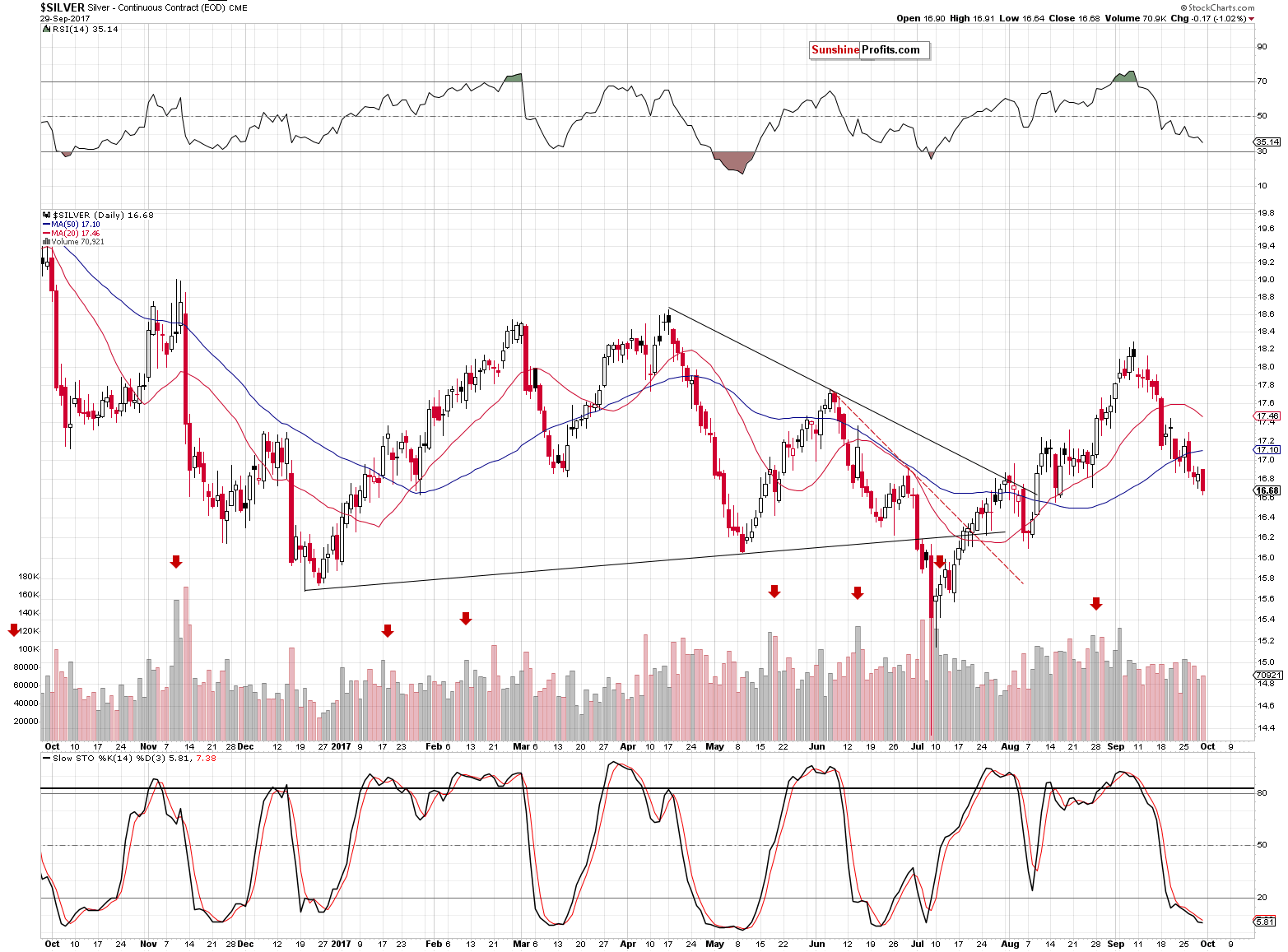
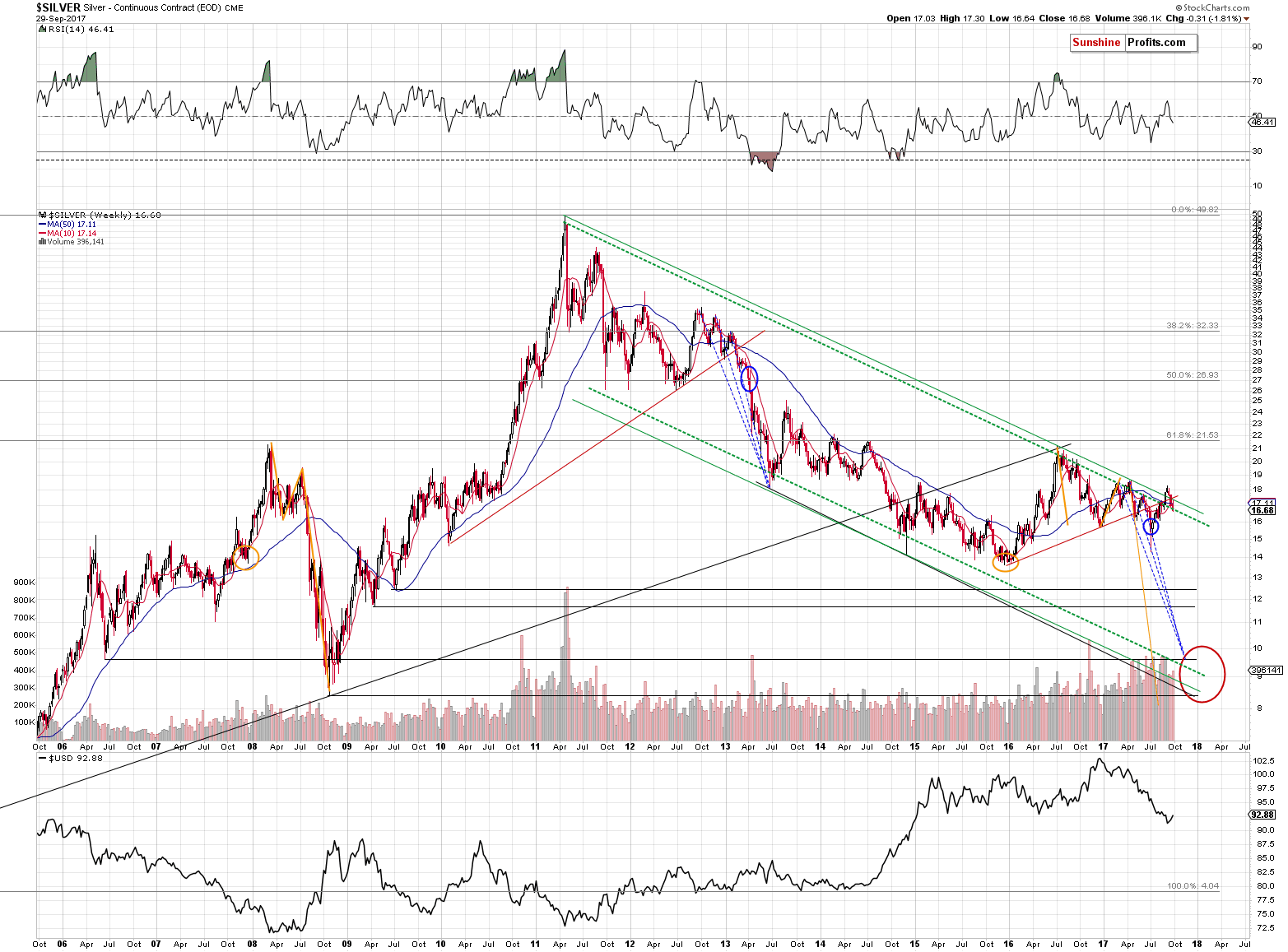
Silver just closed at the lowest level since mid-August and below both declining long-term support/resistance lines. It also closed the week visibly below the rising red support line (visible on the long-term chart).
Last week, we wrote the following:
The change in silver was also very small. It’s not visible from the long-term perspective and from the short-term point of view, we see that the white metal moved just a little higher.
Please note that silver moved back and forth around the $17 level for more than 2 weeks in August, so it wouldn’t be surprising to see some back and forth action also this time. Still, as you’ll see on the following USD Index chart, this kind of action in silver may not take that long.
Since silver closed below the mid-August low (in terms of the daily closing prices), it could indeed be the case that there will be no prolonged sideways trading around the $17 level. This lack of sideways trading would fit the strong bearish implications of the invalidation of the breakdown in terms of the weekly closing prices.
All in all, the outlook for silver deteriorated substantially based on Friday’s closing prices. If it isn’t already clear for many traders, it will likely soon be clear that the next big move in silver is going to be to the downside and at that time the sharp selling would likely follow. It might be difficult to get into a short position at that time – at least at favorable prices.
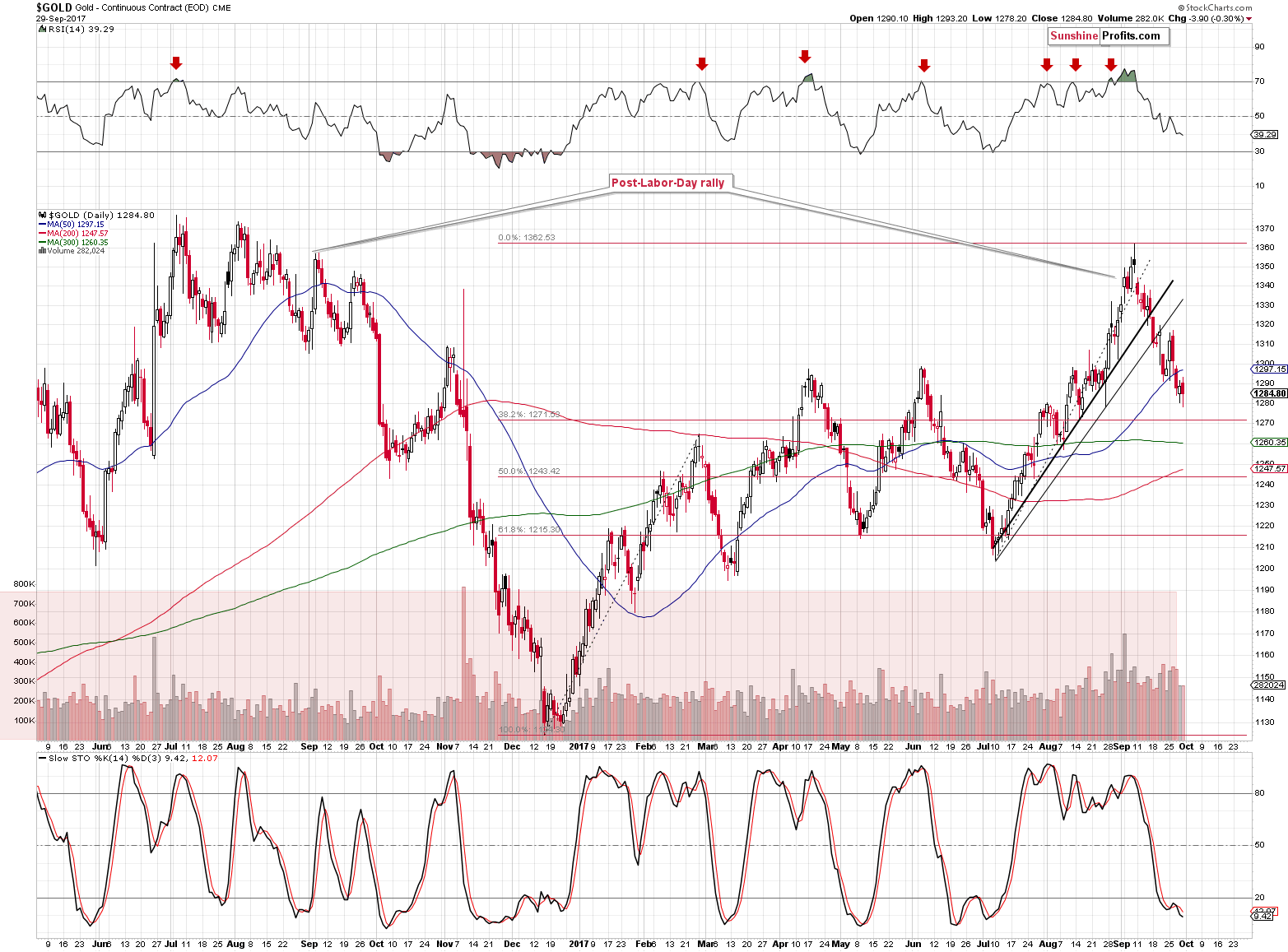
Gold declined as well and it seems that the above chart doesn’t fully reflect the size of the move – based on kitco.com’s prices, the closing price for the week was $1,279.40.
The volume on Friday was not big, but it was not extremely low either, so it’s rather inconsequential. It was very significant from the weekly perspective, though.
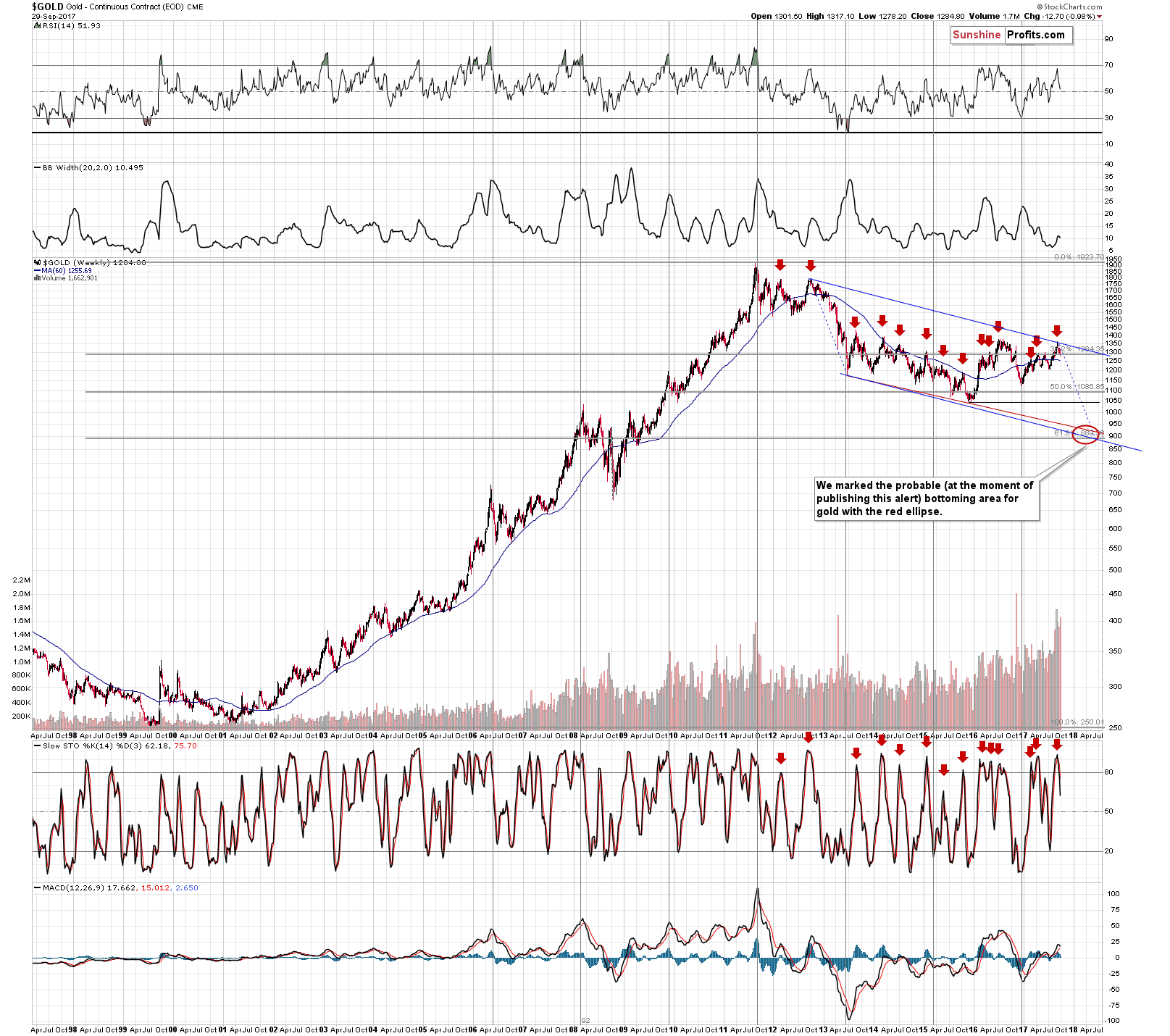
The volume was high from the weekly perspective and the implications are also bearish. The huge and increasing volume along with lower prices is important on its own, but looking at the above chart, we see only one case from the past similar to the current price-volume developments – the 2011 top. It was only then when we also saw a huge spike in volume and also high readings in the following weeks. That was THE top, so it’s quite obvious that the implications of this similarity are bearish.

What’s particularly interesting about the gold market right now is that the bigger the perspective, the more profound and more bearish signals we get.
The above chart based on the monthly candlesticks confirms the above thesis. We discussed the above chart thoroughly in the September 1 Gold & Silver Trading Alert. Back then, we wrote the following:
There are 2 important signals that we would like to discuss: the size of the monthly volume and the decline in the monthly volatility as measured by the Bollinger Band’s width (indicator in the upper part of the chart). There’s also one additional analogy that we’ll discuss later on. Let’s start with the former.
The August volume on which gold rallied in August was huge and it’s directly comparable to only one case from the past – the 2011 top. That’s the only case when gold’s monthly upswing was accompanied by volume that was similarly big. Since that was THE top, the implications here are naturally bearish.
However, there are more analogies that are also important. Considering other monthly volume readings, when gold moved higher on volume that was visibly bigger than the previous values, we get the same implication. We marked the similar cases with red rectangles. Two 2004 declines, the final part of the 2008 decline and – approximately – the 2008 top, the two 2010 corrective downswings, and finally the 2011 top were all accompanied by or preceded by huge monthly volume readings. In 3 cases (the 2008 top, both 2010 corrections) the signal was not precise as the decline started in 2 months not in the next month, but still, the efficiency of this signal in a strong bull market where gold rallied in the vast majority of months, is still remarkable.
The signal that we’re seeing right now is not a minor one – the volume was truly huge and thus the implications are not vague, but clearly bearish at this time.
The width of the Bollinger Bands – a proxy for volatility – confirms the above, by strongly suggesting that a huge move is just around the corner. We added a horizontal line on the BB width chart to better compare its current value to the previous cases when it was seen after a downswing. We marked those cases with vertical dashed lines. There were 4 similar cases: in early 1999 (right before the final downswing of the previous bear market), in mid-2005 (before one of the biggest and sharpest rallies started), in early 2013 (before the biggest and sharpest decline started), and in early 2015 (when the most recent huge decline started). Most of the signals were followed by very important declines even though gold was moving higher for most of the past 2 decades - the implications are once again bearish.
Finally, there’s an interesting analogy between the 2011/2012 tops and the 2016/2017 tops. We marked the link between them with the blue lines. Actually, that’s only one line – between the 2011 and 2012 tops, which is then copied into the current situation. Surprisingly – it fits, which means that in case of the monthly closing prices, the 2017 rally could be just as significant as the 2012 rally. In other words, it could indicate that this year’s move is just a fake rally that’s here to fool the gold bulls, just like the 2012 rally did. Of course, it could be the case that the current rally is a beginning of a new long-term uptrend, but the signals – including the long-term ones - and the way the precious metals sector responded to USD’s decline in the past few months strongly suggest otherwise.
Let’s discuss the last paragraph. The analogy regarding the blue line connecting both (2012 and 2017) tops just got much stronger and so did the bearish implications. The reason is that the similarity now is even stronger. The month that followed both tops (that is tops in terms of monthly closing prices) featured both a temporary move to new short-term highs (above the previous month’s intraday high), and a decline to more or less the beginning of the previous month. In other words, in both cases gold first tried to break above last month’s high and ended up erasing last month’s price gains. This was indeed the case in both October 2012 and September 2017. Based on the above similarity, the analogy is more complete and the link and implications are stronger. The latter are bearish as a huge decline followed the mentioned 2012 developments.
Moving to the analysis of volume, we already wrote about the similarity to the 2011 top, but based on the above chart, we would like to add another comment. Namely, the volume accompanying September’s decline was even higher than the one that we saw in August (we have a new record). This is extremely bearish for three separate, yet connected, reasons:
- The volume that accompanied the decline was bigger than the one that accompanied the decline.
- September’s price action in gold is one big monthly reversal (shooting star) candlestick which was confirmed by extremely high volume.
- Gold’s breakout above the declining long-term resistance line was invalidated and the invalidation took place on huge volume.
No matter how you slice it, what we saw last month in gold was extremely bearish, even though so many investors welcomed gold’s move above $1,300 with thundering ovation.
Let’s stay for a minute with the analogy to 2012-2013 and move the focus to the mentioned Bollinger Bands’ width – a proxy for volatility. It moved below the dashed line and when we saw a similar development back in early 2013 it was shortly before the dramatic plunge. Consequently, it might be a good idea for one to be prepared for an analogous outcome in the following weeks also this time.
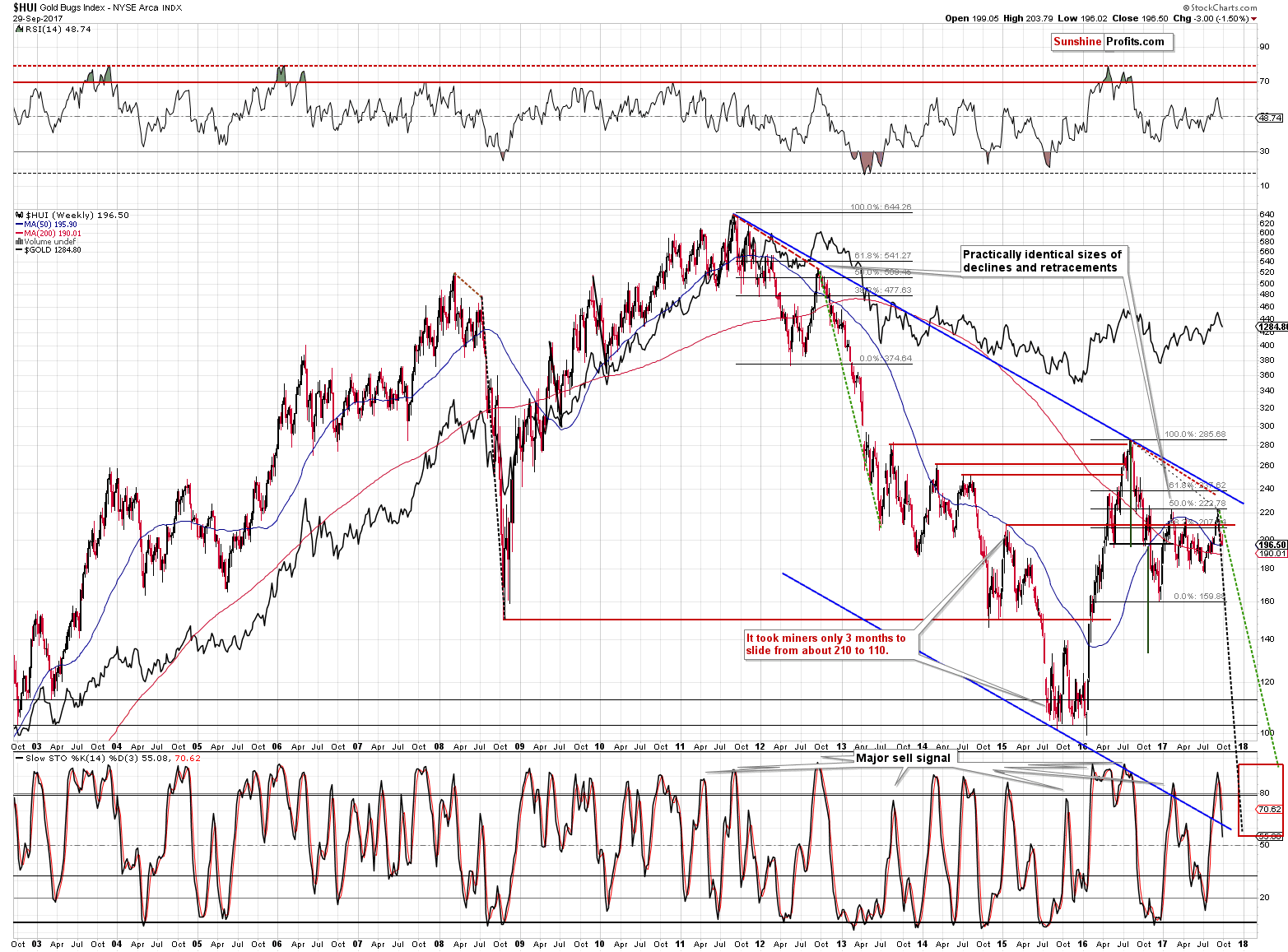
Looking at gold stocks, we see that they are declining at a quite fast pace – more in tune with how they declined in 2008 than in 2013. The weekly sell signals from the Stochastic indicator remain in place in the case of both the HUI and gold and the medium-term implications remain bearish.
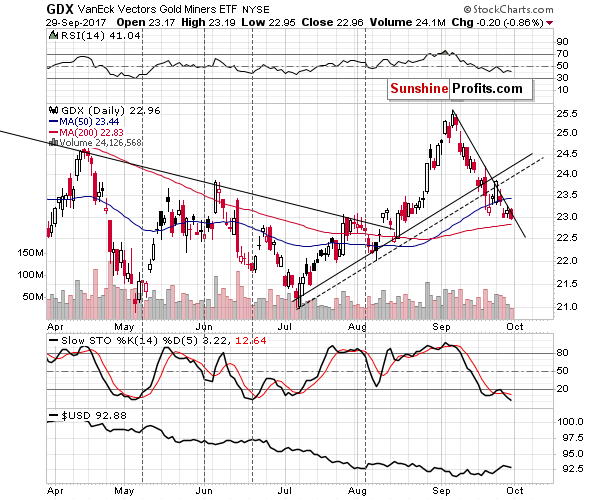
From the short-term perspective, however, we see a bullish signal in the form of low daily volume in the GDX ETF chart. We marked analogous sessions with vertical, gray, dashed lines. The three first cases were preceded by declines, just like last Friday’s session and they were all followed by at least a very short-term upswing. The last analogy (from the first part of August) was followed by a small decline, but it was preceded by a rally, not a decline, and thus it’s not as in tune with what we saw recently as the previous three cases.
The very short-term implications of the above are bullish, but not strongly so. Please note that on Friday, the USD Index declined, while the general stock market rallied – this is an environment in which mining stocks should have rallied. The low volume along with lower price could simply mean that investors were not interested in reacting to the bullish signals and the implications are bearish.
Summing up, based on Friday’s closing prices, which were both weekly and monthly closing prices, the outlook for the precious metals market deteriorated substantially. The price of silver invalidated its previous breakout above the long-term resistance line and it turned out that gold’s September decline was accompanied by record-breaking volume, which is extremely bearish for a few different reasons. The low volume that accompanied the mining stocks’ decline on Friday could have some bullish implications, but they are doubtful (given the USD’s decline and general stock market’s rally) and likely short-lived – the long-term signals are more important than the short-term ones). All in all, the outlook for the precious metals market remains bearish.
As always, we will keep you – our subscribers – informed.
To summarize:
Trading capital (supplementary part of the portfolio; our opinion): Short positions (150% of the full position) in gold, silver and mining stocks are justified from the risk/reward perspective with the following stop-loss orders and initial target price levels / profit-take orders:
- Gold: initial target price level: $1,063; stop-loss: $1,366; initial target price for the DGLD ETN: $81.88; stop-loss for the DGLD ETN $38.74
- Silver: initial target price: $13.12; stop-loss: $19.22; initial target price for the DSLV ETN: $46.18; stop-loss for the DSLV ETN $17.93
- Mining stocks (price levels for the GDX ETF): initial target price: $9.34; stop-loss: $26.34; initial target price for the DUST ETF: $143.56; stop-loss for the DUST ETF $21.37
In case one wants to bet on junior mining stocks' prices (we do not suggest doing so – we think senior mining stocks are more predictable in the case of short-term trades – if one wants to do it anyway, we provide the details), here are the stop-loss details and initial target prices:
- GDXJ ETF: initial target price: $14.13; stop-loss: $45.31
- JDST ETF: initial target price: $417.04; stop-loss: $43.12
Long-term capital (core part of the portfolio; our opinion): No positions (in other words: cash)
Insurance capital (core part of the portfolio; our opinion): Full position
Important Details for New Subscribers
Whether you already subscribed or not, we encourage you to find out how to make the most of our alerts and read our replies to the most common alert-and-gold-trading-related-questions.
Please note that the in the trading section we describe the situation for the day that the alert is posted. In other words, it we are writing about a speculative position, it means that it is up-to-date on the day it was posted. We are also featuring the initial target prices, so that you can decide whether keeping a position on a given day is something that is in tune with your approach (some moves are too small for medium-term traders and some might appear too big for day-traders).
Plus, you might want to read why our stop-loss orders are usually relatively far from the current price.
Please note that a full position doesn’t mean using all of the capital for a given trade. You will find details on our thoughts on gold portfolio structuring in the Key Insights section on our website.
As a reminder – “initial target price” means exactly that – an “initial” one, it’s not a price level at which we suggest closing positions. If this becomes the case (like it did in the previous trade) we will refer to these levels as levels of exit orders (exactly as we’ve done previously). Stop-loss levels, however, are naturally not “initial”, but something that, in our opinion, might be entered as an order.
Since it is impossible to synchronize target prices and stop-loss levels for all the ETFs and ETNs with the main markets that we provide these levels for (gold, silver and mining stocks – the GDX ETF), the stop-loss levels and target prices for other ETNs and ETF (among other: UGLD, DGLD, USLV, DSLV, NUGT, DUST, JNUG, JDST) are provided as supplementary, and not as “final”. This means that if a stop-loss or a target level is reached for any of the “additional instruments” (DGLD for instance), but not for the “main instrument” (gold in this case), we will view positions in both gold and DGLD as still open and the stop-loss for DGLD would have to be moved lower. On the other hand, if gold moves to a stop-loss level but DGLD doesn’t, then we will view both positions (in gold and DGLD) as closed. In other words, since it’s not possible to be 100% certain that each related instrument moves to a given level when the underlying instrument does, we can’t provide levels that would be binding. The levels that we do provide are our best estimate of the levels that will correspond to the levels in the underlying assets, but it will be the underlying assets that one will need to focus on regarding the signs pointing to closing a given position or keeping it open. We might adjust the levels in the “additional instruments” without adjusting the levels in the “main instruments”, which will simply mean that we have improved our estimation of these levels, not that we changed our outlook on the markets. We are already working on a tool that would update these levels on a daily basis for the most popular ETFs, ETNs and individual mining stocks.
Our preferred ways to invest in and to trade gold along with the reasoning can be found in the how to buy gold section. Additionally, our preferred ETFs and ETNs can be found in our Gold & Silver ETF Ranking.
As a reminder, Gold & Silver Trading Alerts are posted before or on each trading day (we usually post them before the opening bell, but we don't promise doing that each day). If there's anything urgent, we will send you an additional small alert before posting the main one.
=====
Latest Free Trading Alerts:
EUR/USD and Bearish Formation on Horizon
Earlier today, the euro extended losses against the greenback, which resulted in a breakdown below the lower border of the trend channel. Will this bearish development trigger bigger move to the downside in the coming week?
Mixed Expectations, Will Stocks Continue Higher?
Earlier today, the euro extended losses against the greenback, which resulted in a breakdown below the lower border of the trend channel. Will this bearish development trigger bigger move to the downside in the coming week?
=====
Hand-picked precious-metals-related links:
Gold Heads for Worst Month in 2017
Gold drops to lowest in nearly 7 weeks; stronger dollar, equities drag
=====
In other news:
Russia left troops in Belarus after wargames: Ukraine
Bitcoin Exchange BTCC Brings Chinese Trading to a Close
=====
Thank you.
Sincerely,
Przemyslaw Radomski, CFA
Founder, Editor-in-chief, Gold & Silver Fund Manager
Gold & Silver Trading Alerts
Forex Trading Alerts
Oil Investment Updates
Oil Trading Alerts



